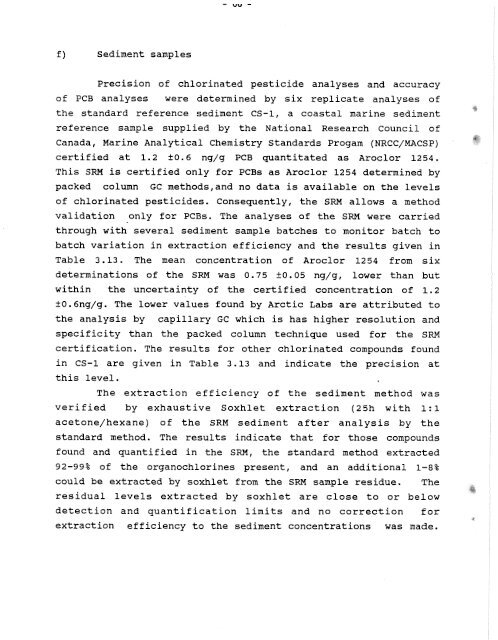Distribution of Chlorinated Hydrocarbon Pesticides and PCBs in the ...
Distribution of Chlorinated Hydrocarbon Pesticides and PCBs in the ...
Distribution of Chlorinated Hydrocarbon Pesticides and PCBs in the ...
You also want an ePaper? Increase the reach of your titles
YUMPU automatically turns print PDFs into web optimized ePapers that Google loves.
f) sediment samples<br />
Precision <strong>of</strong> chlor<strong>in</strong>ated pesticide analyses <strong>and</strong> accuracy<br />
<strong>of</strong> PCB analyses were determ<strong>in</strong>ed by six replicate analyses <strong>of</strong><br />
<strong>the</strong> st<strong>and</strong>ard reference sediment CS-1, a coastal mar<strong>in</strong>e sediment<br />
reference sample supplied by <strong>the</strong> National Research Council <strong>of</strong><br />
Canada, Mar<strong>in</strong>e Analytical Chemistry St<strong>and</strong>ards Progam (NRCC/MACSP)<br />
certified at 1.2 k0.6 ng/g PCB quantitated as Aroclor 1254.<br />
This SRM is certified only for <strong>PCBs</strong> as Aroclor 1254 determ<strong>in</strong>ed by<br />
packed column GC methodst<strong>and</strong> no data is available on <strong>the</strong> levels<br />
<strong>of</strong> chlor<strong>in</strong>ated pesticides. Consequently, <strong>the</strong> SRM allows a method<br />
validation only for <strong>PCBs</strong>. The analyses <strong>of</strong> <strong>the</strong> SRM were carried<br />
through with several sediment sample batches to monitor batch to<br />
batch variation <strong>in</strong> extraction efficiency <strong>and</strong> <strong>the</strong> results given <strong>in</strong><br />
Table 3.13. The mean concentration <strong>of</strong> Aroclor 1254 from six<br />
determ<strong>in</strong>ations <strong>of</strong> <strong>the</strong> SRM was 0.75 k0.05 ng/g, lower than but<br />
with<strong>in</strong> <strong>the</strong> uncerta<strong>in</strong>ty <strong>of</strong> <strong>the</strong> certified concentration <strong>of</strong> 1.2<br />
k0.6ng/g. The lower values found by Arctic Labs are attributed to<br />
<strong>the</strong> analysis by capillary GC which is has higher resolution <strong>and</strong><br />
specificity than <strong>the</strong> packed column technique used for <strong>the</strong> SRM<br />
certification. The results for o<strong>the</strong>r chlor<strong>in</strong>ated compounds found<br />
<strong>in</strong> CS-1 are given <strong>in</strong> Table 3.13 <strong>and</strong> <strong>in</strong>dicate <strong>the</strong> precision at<br />
this level.<br />
The extraction efficiency <strong>of</strong> <strong>the</strong> sediment method was<br />
verified by exhaustive Soxhlet extraction (25h with 1:l<br />
acetone/hexane) <strong>of</strong> <strong>the</strong> SRM sediment after analysis by <strong>the</strong><br />
st<strong>and</strong>ard method. The results <strong>in</strong>dicate that for those compounds<br />
found <strong>and</strong> quantified <strong>in</strong> <strong>the</strong> SRM, <strong>the</strong> st<strong>and</strong>ard method extracted<br />
92-99% <strong>of</strong> <strong>the</strong> organochlor<strong>in</strong>es present, <strong>and</strong> an additional 1-8%<br />
could be extracted by soxhlet from <strong>the</strong> SRM sample residue. The<br />
residual levels extracted by soxhlet are close to or below<br />
detection <strong>and</strong> quantification limits <strong>and</strong> no correction for<br />
extraction efficiency to <strong>the</strong> sediment concentrations was made.

















